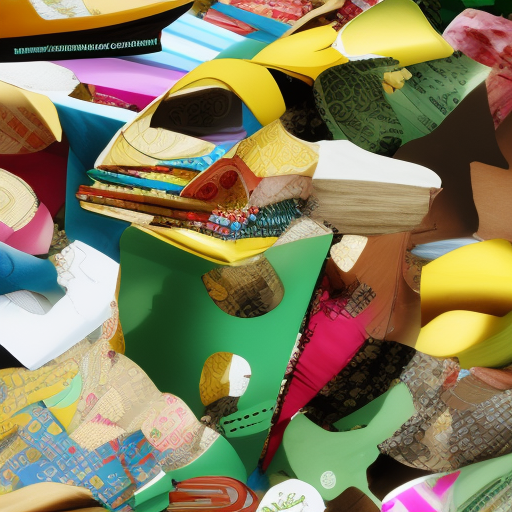Recycled Crafts: Turning Trash into Treasure

1. Introduction
Recycled crafts are a great way to reduce waste and promote sustainability. By repurposing materials that would otherwise end up in landfills, we can create unique and beautiful objects that celebrate the power of creativity and resourcefulness. In this article, we’ll explore the world of recycled crafts and show you how to turn trash into treasure. We’ll cover everything from paper crafts to metal crafts, glass crafts, clothing upcycling, furniture upcycling, art from trash, and even provide information on local recycling centers. So let’s get started!

2. Paper Crafts
Paper crafts are a great way to recycle everyday materials and turn them into beautiful and functional pieces of art. From paper flowers to paper mache, there are countless ways to use paper as a medium for crafting.
One of the best things about paper crafts is their versatility. Almost any type of paper can be used, including printer paper, cardboard, and even newspaper. This means that almost anyone can get started with paper crafting, regardless of their skill level or experience.
To create paper crafts, all you need is some paper, glue, scissors, and perhaps some other basic crafting tools like a ruler or a pencil. There are many step-by-step instructions available online for creating various paper crafts, so you can choose a project that fits your interests and skill level.
Some examples of popular paper crafts include paper flowers, which can be used as decorations or gifts; paper mache, which involves covering a paper base with a mixture of glue and sawdust to create a sturdy and durable object; and origami, which involves folding paper to create intricate designs and shapes.
In addition to being fun and creative, paper crafts have several benefits. They help reduce waste by giving new life to old papers, they are relatively easy to do and require few materials, and they can be used to create a wide variety of objects, from decorative pieces to functional household items.
Overall, paper crafts are a great way to get involved in recycling and sustainability while also having fun and expressing your creativity. So why not give it a try?

3. Metal Crafts
Metal crafts are a great way to reuse and repurpose materials that would otherwise end up in a landfill. From jewelry making to sculpture creation, there are many ways to turn old metal objects into beautiful works of art.
One popular type of metal craft is jewelry making. This can involve repurposing old broken jewelry, or even using scrap metal to create unique pieces. For example, you could take an old silver necklace and melt it down to create a new piece of jewelry with a completely different design.
Another option for metal crafts is sculpture creation. This can be done with a variety of metals, including copper, brass, and steel. By bending, shaping, and welding the metal, artists can create all sorts of interesting forms and designs. Some sculptures may have a functional element, such as a decorative lamp, while others may simply be a work of art.
Regardless of the type of metal craft, there are many benefits to this form of upcycling. Not only does it reduce waste by giving new life to old materials, but it also allows artists to express their creativity in a unique way. Additionally, many metal crafts can be sold or gifted, providing a way to share the beauty of recycled materials with others.

4. Glass Crafts
Sure thing! Here’s some content for the “Glass Crafts” section:
Glass crafts are a beautiful and unique way to recycle materials and create something new and beautiful. From stained glass windows to fused glass artwork, there are many different techniques and styles to explore when it comes to working with glass.
One popular technique is stained glass, which involves cutting pieces of colored glass into various shapes and arranging them to form a design. This can be done with traditional leaded glass, or with modern methods such as copper foil or fusing. Stained glass can be used to create window panels, lampshades, and even jewelry.
Another option is fused glass, which involves melting glass at a high temperature to create a single piece of artwork. This can be done using a kiln, which is a specialized piece of equipment that allows the artist to control the temperature and timing of the process. Fused glass can be used to create everything from small decorative objects to large murals.
Both stained glass and fused glass require patience and attention to detail, but they can also be very rewarding projects. In addition to being a fun hobby, making glass crafts can also be a great way to reduce waste and support sustainability. By repurposing glass that might otherwise end up in a landfill, artists can create beautiful and unique works of art while also doing their part to protect the environment.

5. Clothing Upcycling
Turning old clothes into something new and stylish is a great way to reduce waste and promote sustainability. Clothing upcycling involves taking old garments and giving them a new lease on life by altering their shape or style. This can be done through a variety of techniques such as cutting, sewing, and embellishing.
One popular clothing upcycling project is turning old t-shirts into purses. To do this, start by cutting the shirt into two pieces, one for the top of the purse and one for the bottom. Then, sew the two pieces together to create the body of the purse. Add handles and a closure, such as a zipper or snap, and you have a new bag made from an old t-shirt.
Another option is to turn old jeans into a denim jacket. Start by cutting out the sleeves and collar of the jacket, then use the remaining fabric to create a new front and back panel. Sew the panels together and add any additional details, such as pockets or buttons, to complete the jacket.
Clothing upcycling not only helps reduce waste but also saves money and resources. Instead of buying new clothes, upcycling allows you to give new life to existing items, making them feel fresh and new again. It’s also a fun and creative way to express your personal style. So why not give it a try?

6. Furniture Upcycling
Transforming old and outdated furniture into something beautiful and functional is not only a great way to give new life to unwanted pieces, but it also helps reduce waste and conserve natural resources. Furniture upcycling involves taking a piece of furniture that is no longer needed or wanted and giving it a new lease on life through repair, refinishing, and reimagining its design.
There are many ways to upcycle furniture, including changing the finish, adding new hardware, repurposing parts, and even completely rebuilding the piece. For example, an old dresser could be transformed into a coffee table, or an old chair could be turned into a plant stand. The possibilities are endless when it comes to furniture upcycling.
One of the benefits of upcycling furniture is that it helps reduce waste by keeping useful items out of landfills. Additionally, upcycling often requires fewer resources than producing new furniture, making it a more environmentally friendly option. Finally, upcycled furniture can add unique character and charm to a room, making it a perfect fit for any home.
If you’re interested in furniture upcycling, there are many resources available to help you get started. Local thrift stores and secondhand shops often have donated furniture that can be upcycled. You can also search online for upcycling tutorials and inspiration. With a little creativity and elbow grease, you can turn old and outdated furniture into something beautiful and functional.

7. Art from Trash
Transforming trash into art is not only a creative way to reduce waste, but it also serves as a powerful statement about the potential of materials that might otherwise be discarded. From trash bin sculptures to upcycled household items, there are endless possibilities for creating unique and beautiful pieces of art using items that would otherwise be thrown away. In this section, we will explore some examples of art made from trash, as well as provide step-by-step instructions for creating your own masterpiece.

8. Recycling Centers
Sure thing! Here’s some content for the “Recycling Centers” section:
Section 8: Recycling Centers
——————————
If you’re looking to take your recycling efforts to the next level, consider visiting your local recycling center. These centers provide a convenient way to recycle a wide range of materials, including plastics, metals, paper, glass, and electronics. By properly disposing of these items, you can help reduce the amount of waste sent to landfills and protect the environment.
When visiting a recycling center, it’s important to know what items can be recycled and how to properly prepare them for recycling. Many centers have specific guidelines for each type of material, so be sure to check their website or ask a staff member for assistance. Some common items that can be recycled include plastic bottles, cardboard boxes, aluminum cans, and electronic devices such as computers and televisions.
In addition to recycling, many recycling centers also offer programs for composting food scraps and yard waste. Composting helps to reduce the amount of organic waste sent to landfills, where it can create methane gas, a potent greenhouse gas. By composting your food scraps and yard waste, you can turn them into nutrient-rich soil that can be used to grow healthy plants and gardens.
To get started with recycling and composting, check out your local recycling center to learn more about their programs and services. You may also want to consider starting a compost pile in your own backyard, which can be done with a simple bin or container filled with soil and a mixture of browns (such as dried leaves and grass clippings) and greens (such as kitchen scraps). As your compost pile breaks down, you’ll notice a reduction in the amount of garbage you produce, and you’ll be doing your part to create a more sustainable future for our planet.

9. Conclusion
In conclusion, recycled crafts offer a unique way to reduce waste and promote sustainability. From paper crafts to metal crafts, glass crafts to clothing upcycling, there are countless ways to turn trash into treasure. By taking advantage of these opportunities, we can all do our part to protect the environment and create something beautiful in the process. Whether you’re an experienced crafter or just starting out, there’s never been a better time to get creative with recycled materials. So why not give it a try?


0 Comments